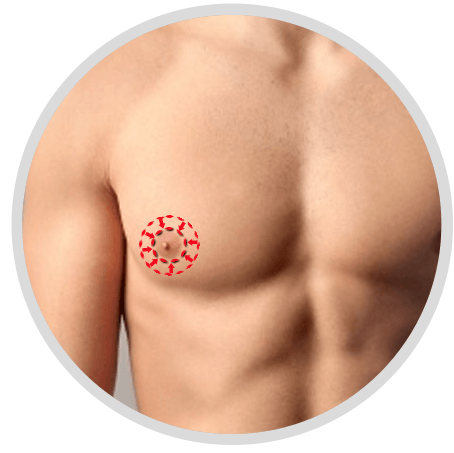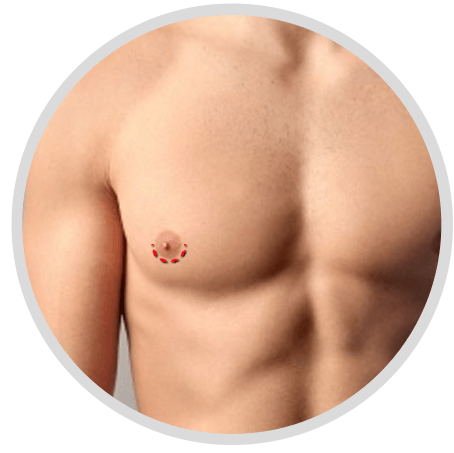Introduction to FTM Top Surgery
Every human being can look at their life as an evolving journey. For transgender men, this journey takes on many different meanings. There is the emotional and spiritual journey, the biologic journey, and the physical journey. The physical journey is the culmination, the last piece of the so-called puzzle to complete the transformation that for most began many years ago.
One of the most important parts of their physical transformations is referred to as female to male (FTM) top surgery. This is a surgery designed to transform the appearance of a female breast to a masculine chest. It is a procedure that in a matter of a few hours can alter the trajectory of one’s life for years to come. Dr. Dadvand specializes in FTM top surgery and takes great pride in fulfilling this aspect of your journey. As a practice, we strive to create a warm and comfortable environment, one which balances a sense of family with professionalism. It is a relationship that continues long after the final stitch is placed and the bandages are applied.
Fortunately, times are slowly changing for the better. Transgender people are getting their voices heard and the message is simple: Every human being has the right to be themselves, to be true to themselves, and receive fair and equal treatment. There is a growing movement to educate the general population, to legislate against discriminatory practices, and most importantly to enable you to live the life you were meant to live.
In addition to participating in the physical transformation of his patients, Dr. Dadvand takes a more active role by contributing a portion of the surgical fees to Transforming Family, a Los Angeles based family support group creating a positive environment for children, adolescents, and their families to explore issues of gender identity.
FTM Top Surgical Procedures

Double Incision Top Surgery
Men who have medium to large chests benefit most from the double- incision top surgery technique. In this procedure, an incision is made along the lower breast fold and the breast tissue is meticulously reduced. The excess skin is then reduced to create a pleasing, more masculine contour. The nipple and areola, which are removed at the beginning of the procedure are then re-sized and sutured to the appropriate position to give a more masculine appearance. Liposuction of the axilla and lateral breast and chest are also performed as necessary. The advantage of this procedure is that it offers the best contour for the chest. The main disadvantage is that nipple sensation is typically lost. The final incisions, which are along the lower border of the chest and around the areola fade over time.
The double incision technique is an outpatient procedure performed under general anesthesia. The surgery generally takes between 2.5-3.5 hours.
Double Incision Top Surgery Post Op Care
After surgery, you will have a drainage tube in place on each side. Dr. Dadvand sees all of his patients the next day to go over instructions and drain management. The drains stay in place until they are each putting out less than 20ml/24 hours. This usually occurs between 4-7 days. You will also have compression dressings and a compression garment.
Dr. Dadvand will then see you when you are one week out from surgery to remove the drains, any sutures, and the compression dressings. This is the Grand Reveal, a very emotional day for everyone involved!
You will continue to wear the compression garment for 6 weeks on average. Dr. Dadvand will see you at this time to determine when you may resume exercise. Walking is permitted after surgery, but strenuous activity, exercise, and regular lifting of your arms over your head are to be avoided. This is to ensure that the swelling is controlled as well as to decrease the stress on the incisions.
Periareolar Surgery
Men who have small to medium breasts (A to B cup) and large areola with minimal to no excess skin benefit most from the periareolar surgery technique. An incision is made around the entire areola and breast and excess fatty tissue is taken out. A concentric incision is then made and the intervening skin is removed. A purse-string suture is then used to tighten the skin around the new areola. The final incision is limited to the areola. In certain cases, this may need to be performed in two stages to ensure adequate blood supply to the nipple and areola.
The periareolar technique is an outpatient procedure performed under general anesthesia. The surgery generally takes between 3-4 hours.

Periareolar Surgery Post Op Care
After surgery, you will have a drainage tube in place on each side. Dr. Dadvand sees all of his patients the next day to go over instructions and drain management. The drains stay in place until they are each putting out less than 20ml/24 hours. This usually occurs between 4-7 days. You will also have compression dressings and a compression garment.
Dr. Dadvand will then see you when you are one week out from surgery to remove the drains, any sutures, and the compression dressings. This is the Grand Reveal, a very emotional day for everyone involved!
You will continue to wear the compression garment for 6 weeks on average. Dr. Dadvand will see you at this time to determine when you may resume exercise. Walking is permitted after surgery, but strenuous activity, exercise, and regular lifting of your arms over your head are to be avoided. This is to ensure that the swelling is controlled as well as to decrease the stress on the incisions.
Keyhole Top Surgery
Men who have small chests benefit most from the keyhole top surgery technique. In this procedure, an incision is made along the lower border of the areola and breast tissue is taken out. This is accompanied by liposuction as necessary. The areola is not reduced in size but the nipple can be reduced in size. The sensation is typically left intact.
The keyhole technique is an outpatient procedure performed under general anesthesia. The surgery generally takes between 2- 3 hours.

Keyhole Top Surgery Post Op Care
After surgery, you will have a drainage tube in place on each side. Dr. Dadvand sees all of his patients the next day to go over instructions and drain management. The drains stay in place until they are each putting out less than 20ml/24 hours. This usually occurs between 4-7 days. You will also have compression dressings and a compression garment.
Dr. Dadvand will then see you when you are one week out from surgery to remove the drains, any sutures, and the compression dressings. This is the Grand Reveal, a very emotional day for everyone involved!
You will continue to wear the compression garment for 4-6 weeks on average. Dr. Dadvand will see you at this time to determine when you may resume exercise. Walking is permitted after surgery, but strenuous activity, exercise is to be avoided. This is to ensure that the swelling is controlled and allow the skin to re-drape.
“Dr. Dadvand is one of the best doctors I know. All around, he has a great personality, sense of humor is very knowledgeable and really tries his best to make sure that you are getting what you want. He has really helped me boost my confidence up, not only with just my procedure, but everything he has said to me regarding my transition has made a positive impact. He doesn’t try to rush your appointments, but he really takes the time to get to know you and get a better idea of who you are as a person.
“My surgery itself was a great success. He was so thorough with the pre-op appointment that I knew exactly what to expect. Since this was my first surgery ever, I was initially very nervous about the process but he always reassured me that I would be okay. Post-op care was also great. He taught both my mom and me how to care for my wounds. Dr. Dadvand is just awesome. I’m so happy we found him. I plan on getting more work done by him in the future.”
Dre Barnachea
“Dr. Dadvand is the best, he is truly a great doctor. Very understanding and great for a mastectomy for my transgender son. We will forever be grateful for Dr. Dadvand giving my son a new life. Thank you!!”
Becky Adan
FTM Top Surgery FAQ
Q: What is FTM Top Surgery?
A: FTM (Female to Male) top surgery is a surgical procedure designed to transform the appearance of a female breast to a masculine chest. This involves the reduction of breast tissue, excess skin, and or repositioning and reducing the areola and nipple.
Q: Who is a candidate for FTM Top Surgery?
A: The criteria for FTM TOP surgery are set out by the World Professional Association for Transgender Health (WPATH) and consist of the following:
- Persistent, well-documented gender dysphoria
- Capacity to make a fully informed decision and to consent for treatment
- Be of the age of majority in the country of surgery (and follow SOC rules for children and adolescents*)
- Significant medical or mental health concerns, if present, must be reasonably well controlled at the time of surgery
In addition, Dr. Dadvand requires a referral letter from the patient’s therapist stating that they are ready for transformational surgery. The letter must be signed by the provider, printed on letterhead, and include the following:
- Patient’s legal and preferred name
- Patient date of birth
- Date provider/patient relationship began and frequency of contact
- That patient has the capacity to make fully informed decisions and consent to treatment
- That patient has been diagnosed with Gender Identity Disorder/Gender Dysphoria and exhibits all of the following:
- The desire to live and be accepted as a member of the opposite sex, usually accompanied by the wish to make his or her body as congruent as possible with the preferred sex through surgery and hormone treatment; and
- The transsexual identity has been present persistently for at least two years; and
- The disorder is not a symptom of another mental disorder; and
- The disorder causes clinically significant distress or impairment in social, occupational, or other important areas of functioning.
Q: Do I need to be on testosterone before I can get top surgery?
A: No, WPATH Standards of Care do not require hormone therapy to be eligible for top surgery.
Q: How much time will I need to take off work/school after my top surgery?
A: Most people take off one week from work. However, this depends on the job. For more physically demanding jobs, this may need to be extended to two weeks and possibly a light duty position for a week or two upon return. Students who undergo top surgery typically take 1 week off from school.
Q: How long will I need to stay in Los Angeles after my top surgery?
A: If you are traveling from out of state for FTM top surgery Dr. Dadvand will need you to stay in the area for about a week for your post-operative appointments.
Q: Will I need to wear a compression vest after my top surgery?
A: Yes. If you have double incision or peri-areolar top surgery, you should wear the binder for 6 weeks to promote good healing and low scarring. If you have keyhole top surgery, you will need to wear the compression vest for 4-6 weeks.
Q: Will I have drains after my top surgery?
A: Yes, Dr. Dadvand utilizes drains for all of the different FTM top surgery techniques. This will reduce your risk of the fluid collection (seroma) and increase the rate of skin re-draping.
Q: Will I be in much pain after surgery?
A: Pain is very subjective and differs from person to person. Generally speaking, the pain is minimal to moderate. Dr. Dadvand prescribes Norco for pain control. Most patients do not even finish the prescribed amount.
Q: Will I need to have any stitches taken out after my top surgery?
A: Dr. Dadvand uses multiple layers of absorbable sutures underneath the skin. There may be some sutures on the skin which Dr. Dadvand will remove at your 1-week visit. There is little to no pain involved and should not require pain medication.
Q: When can I go back to the gym for regular workouts?
A: Light activity such as walking is recommended starting the evening of surgery. It promotes good healing and decreased the risk of blood clots. For more strenuous workouts, with weight training especially, you should wait 6 weeks minimum. This is to allow the swelling to subside and minimize the chance for the scars to widen.
Q: When can I take a shower or bath?
A: Most patients can shower after 48 hours, but you cannot get your chest wet due to the special dressings that Dr. Dadvand uses. These dressings come off on day 6 and after that, you will be able to get your chest wet.
Q: How can I minimize the scars from my top surgery?
A: For the Double Incision top surgery and the Periareolar top surgery, Dr. Dadvand recommends scar treatment for 3 months. This is the time that the scars are the most inflamed. In addition, you need to avoid excessive arm and chest movements in the first 6 weeks.
Q: Do you accept insurance for FTM top surgery?
A: We have received many requests from patients for documentation to apply for reimbursement from their insurance carrier for some or all of their FTM top surgery procedure costs. While our practice does not accept insurance for the FTM top surgery procedure, we will provide you with a letter describing the FTM top surgery procedure and also provide some acceptable CPT codes for insurance reimbursement. The letter will be provided after surgery only.
Q: How much does FTM top surgery cost?
A: The cost of FTM top surgery depends entirely on the surgeon and the location of the practice you are visiting. Dr. Dadvand works closely with each patient to create an individualized treatment plan. He will discuss the procedure as well as its cost during your consultation.
Q: Can your breasts come back after FTM top surgery?
A: Patients wanting to undergo FTM top surgery in LA often ask whether or not their breasts can come back if they put on weight. While every procedure comes with its own unique risks and potential complications, FTM top surgery is permanent.
Q: Do you lose nipple sensation after FTM top surgery?
A: You may lose a small amount of sensation in the nipples after FTM top surgery. The sensation after surgery is similar to that of the upper chest just before your operation. Dr. Dadvand will walk you through all of the potential side effects of the surgery during your initial consultation.
Q: When can I stop sleeping on my back after FTM top surgery?
A: After your FTM top surgery in Beverly Hills, it is important that you sleep on your back for the first 2 weeks during your initial recovery period. Once this period is over, you may start sleeping on your side if it feels more comfortable. Whatever you do, do not lift any heavy objects and do not do any intensive exercise until Dr. Dadvand allows it.
Q: How long do I have to wear a binder?
A: For three weeks following your procedure, Dr. Dadvand will ask you to wear a compressive bandage called a binder around your chest. This will help your chest heal. He will remove the binder during your first check-up. He may reapply one after your check-up if he deems it necessary.
If you would like to read more about Dr. Dadvand’s FTM procedures, click here.

By Dr. Babak Dadvand
Dr. Babak Dadvand is a board-certified plastic surgeon and portrait painter, providing a distinctive fusion of artistic and surgical skills to achieve exceptional outcomes, all while maintaining a robust ethical framework that prioritizes patient trust and satisfaction.








 4.9 stars - based on 106 reviews
4.9 stars - based on 106 reviews
 4.9 stars - based on 73 reviews
4.9 stars - based on 73 reviews
